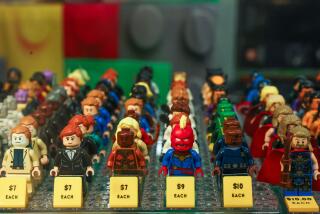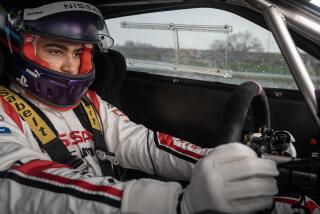Sony’s ‘Gran Turismo 2’ Ride as Good as It Gets
- Share via
You know you’re in for an experience when a console racing game comes packed with a user’s manual and a separate reference manual--for a total of 110 pages of reading. Come on, console racers are traditionally the simplest of the simple.
Step on the gas.
Go.
Go faster.
Steer.
Win.
That was, until “Gran Turismo” for Sony PlayStation turned everything upside down in 1998 with a racing game that required not only keen driving skills, but the smarts to know how to manage a career as well. It would be unfair to call the sequel, “Gran Turismo 2,” a mere offspring, because this is the Big Daddy of console racing games.
Let’s just dispense with the disclaimer first: Of course the game doesn’t look as sharp as even the shoddiest racer on the newer Sega Dreamcast. Duh. Dreamcast has more than four times the processing power of PlayStation. Even so, “Gran Turismo 2” gives digital drivers all the adrenaline they crave and all the details they respect.
As in the first game, players can choose from the simpler arcade mode or the more complex simulation mode. Each is housed on its own disc. The choice of cars is staggering: More than 500 models representing nearly 40 manufacturers as diverse as Mercedes-Benz and Daihatsu. The selection of tracks is incomparable: More than 20 spread across the globe, including dirt rally tracks.
Winning at “Gran Turismo 2” requires understanding the physics of driving--from how weight transfers during turns to how engine placement affects power distribution--as well as knowing the individual quirks of the cars and the nuances of the tracks. Happily, control is tighter than any other PlayStation racer on the market.
Players start with humble cars and little cash to make repairs. The key to progressing in “Gran Turismo 2” lies in winning races. Victory brings cash and cash has so many uses. In “Gran Turismo 2” it’s used to buy new parts and new cars and even keep cars looking shiny and new. Players can modify mufflers, brakes, engines, drive trains, turbochargers, suspensions, tires and can even tinker with the sophisticated systems such as traction control.
It just doesn’t get any better than “Gran Turismo 2.”
‘Lego Rock Raiders’
Parents may find “Lego Rock Raiders” cooler than their kids do.
Oh, sure, it’s got all the elements of a great kiddie game. The mining spaceship LMS Explorer is returning home from a long, hard trip harvesting space crystals when it gets knocked around in an asteroid field. The Explorer tumbles into a wormhole that warps the vessel and her crew into a strange galaxy. The only way to get home is to collect enough energy crystals from the nearest planet to make repairs and power the ship.
The mission may be life and death for the pudgy little Rock Raiders, but it’s also a lot of fun--at least for those who have the patience to direct the crew around the planetary surface drilling for crystals, building bases and making sure individual Raiders get enough to eat. At its heart, “Lego Rock Raiders” is a real-time strategy game not unlike “Age of Empires” or “Starcraft.”
Yes, it’s easier and the mission objectives are not nearly as bloodthirsty as most real-time strategy games. But “Lego Rock Raiders” still requires the sort of planning and management that make its more sophisticated cousins so enthralling for so many players. I question, though, whether most little kids have the patience to sit and wait for their digital Rock Raiders to collect enough ore to build a mess hall.
The game utilizes the standard top-down three-quarters perspective found in almost every real-time strategy title. Players can spin the map for a better view of the action and zoom in or out for details. One cool feature is the ability to get right down into the action and view the world through the eyes of a Rock Raider.
Not that it’s all that exciting most of the time. Much of the game focuses on the collection of ore and crystals. In progressively more difficult levels, players start with a skeleton crew and only the most basic of outposts. As Rock Raiders drill into the ubiquitous rock walls, they find the raw materials necessary to build better command centers, vehicles and even training centers to educate them on the use of explosives.
Awesome.
Graphically, the game is nothing special--even though it requires graphics hardware to run. It can sometimes be difficult to see which Rock Raiders are doing what in the game, and much of the terrain is painfully dull.
Even so, the game is something of a breakthrough for Lego Media, the interactive arm of the Danish toy maker. “Lego Rock Raiders” represents the first time the company developed a computer game simultaneously with an actual line of toys. The “Rock Raiders” line of Lego appeared in stores last summer. The idea is to create a seamless transition between real play and virtual play.
I would bet, however, that the Rock Raiders building sets just give kids something to do while their parents puzzle through the game.
“Lego Rock Raiders” requires a Pentium 200 with 32mb of RAM, 200mb of available hard disk space and graphics hardware with at least 4mb of video memory.
‘Toy Commander’
What a great concept. What a mediocre game. Most of the games so far on “Sega Dreamcast” have been great executions of familiar concepts--fighting, sports and racing--but “Toy Commander” sets a higher bar.
And ultimately misses it.
It seems some of the toys in Andrew Guthy’s room have taken up arms in mutiny, under the direction of the stuffed Huggy Bear. Huggy and his compatriots feel neglected because newer toys get all the attention. It sounds familiar, I know, but the problem is resolved in anything but a Disney way.
The goal of “Toy Commander” is to suppress the mutiny by challenging the rebel toys to various timed challenges around the house--everything from using a tank to get a couple of eggs boiling to racing toy airplanes. All of the action takes place in various rooms of Andy’s house. As toys are conquered, they submit and turn their wrath on Huggy.
Some of the challenges are inventive, but too many feel repetitive. And control is often herky-jerky, making it tough to get the job done. Graphically, the game delivers everything one should expect from Sega’s 128-bit Dreamcast.
After a few levels, though, the single-player version of “Toy Commander” gets monotonous. The multiplayer mode allows up to four competitors to blast each other with toys. It’s fun for a while, but then feels like every other multiperson death match.
Aaron Curtiss, formerly a Times editorial writer, is participating in a management training program, where he currently serves as assistant to the senior vice president of advertising. He has no financial dealings with the companies he covers. To comment on a column or to suggest games for review, send e-mail to aaron.curtiss@latimes.com.
(BEGIN TEXT OF INFOBOX / INFOGRAPHIC)
Essentials
Gran Turismo 2
* Platform: Sony PlayStation
* Publisher: Sony Computer Entertainment America
* ESRB* rating: Everyone
* Price: $39.99
* Bottom line: As good as it gets
Lego Rock Raiders
* Platform: PC
* Publisher: Lego Media
* ESRB* rating: Everyone
* Price: $39.99
* Bottom line: Simple real-time strategy
Toy Commander
* Platform: Sega Dreamcast
* Publisher: Sega
* ESRB* rating: Everyone
* Price: $39.99
* Bottom line: Unrealized potential
* Entertainment Software Ratings Board
Next Week:
40 Winks, Omikron and Turok Rage Wars
More to Read
The biggest entertainment stories
Get our big stories about Hollywood, film, television, music, arts, culture and more right in your inbox as soon as they publish.
You may occasionally receive promotional content from the Los Angeles Times.










